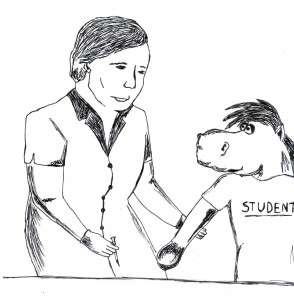The staff editorial is the majority opinion of The Murray State News Editorial Board.

Our society has grown significantly more aware of the grasp HIV/AIDS can have on victims and their loved ones, but there is still more we can do for ourselves.
With the epidemic’s initial media outburst in the 1980s after a study conducted by the U.S. Centers for Disease Control and Prevention, it was the common misconception that only homosexuals and drug addicts could carry such a debilitating disease.
As decades passed, we learned that HIV/AIDS reached far beyond those demographics, taking the lives of both children and adults.
In 2007, there were more than 565,000 AIDS-related deaths, and that didn’t count people who were infected and still alive.
The nation followed suit, making HIV/AIDS?testing easily accessible in places like clinics, schools, jails and prisons.
World AIDS Day is one of many events to create awareness and educate people on how to prevent and cope with the disease, and began as a response to growing rates of infection.
We understand that the threat of HIV/AIDS as a disease is just as much a reality for a college student on Murray State’s campus as it is for anyone else. Currently, the southern region of the U.S. has the highest growth rate of HIV/AIDS in the country.
Murray State organizations such as the LGBT program and the gender diversity studies departments have offered their own philanthropies to raise community awareness.
Besides raising money, it is also imperative that we take the initiative to get ourselves tested. Not only for a lifted conscience but for the sake of our health and our partners’.
HIV/AIDS testing is offered by Health Services, and we should be taking advantage of them.
Students are quick to make appointments at Health Services for sore throats, colds and fevers. The same should be said for AIDS testing or for any other sexually transmitted diseases.
There is currently no confirmed cure for HIV/AIDS, so students should prioritize testing before it becomes an issue.
Once they are infected, carriers learn to deal with symptoms potentially for the rest of their lives.
In some cases, carriers feel no symptoms and do not discover they are a carrier until years later, after they have transmitted it to other people.
The unnoticeable symptoms should influence students to take more preventative measures, and they should never go only by the word of a partner that they are disease-free.
Other preventative measures, such as using condoms during sex, aren’t pushed in high school health classes for no reason.
Condoms can prevent infection and should be used when engaging with someone you are not sure has been tested.
Because of the stereotypical promiscuity of college students, the potential for something as deadly as AIDS to come so close to us has never been so real.
Studies show one in four people is currently infected with a sexually transmitted infection, and this includes HIV/AIDS.
Before snickering at a jar of free condoms at the clinic or opting out of HIV/AIDS tests out of embarrassment or laziness, we should all begin to think twice after seeing the devastating results and rates of infection that are active in the U.S. today.
We are far from having an ideally AIDS-free generation, but testing ourselves and urging the testing of our partners and friends is a step toward prevention, and should be a responsibility for any college student.
